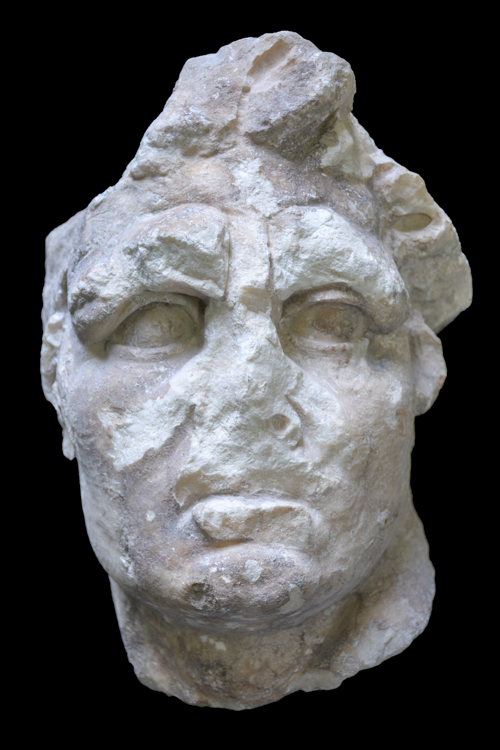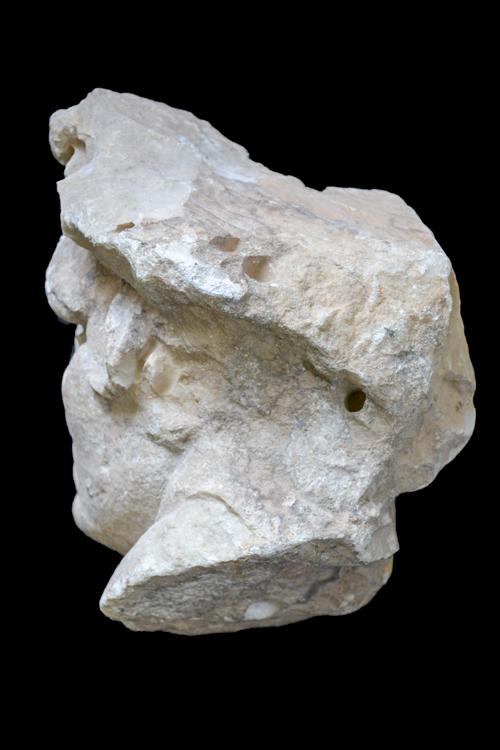Fragmented male head
Category
HeadsAbout This Artefact
I.D. no: 35692
Dimensions: H. 36 cm; W. 25 cm
Material: Fine-grain white marble. Pentelic (according to Ashby)
Provenance: Unknown
Current location: National Museum of Archaeology
Condition: The back and upper part of the head are missing with three large breaks that affect the cranium from above the forehead to the nape of the neck. As a result all the hair cover is missing except for some tufts surviving above the forehead, left temple, in front of each ear, and above the nape. The face has suffered considerable damage: the nose is almost completely missing, sparing only the left nostril hole; large chips on both lips, both eyebrows, right cheek, smaller ones on the right ear (the left one is almost completely missing) and all over the facial surface. The whole face is covered by a dark brown patina, resulting from natural weathering, apart from the areas of the modern breakages and abrasions, but not the large, multifaceted breaks at the back. The head must have been broken off from either a free-standing statue or from a figure in very high relief.
Description: The head has heavy features with massive jaws, prominent chin and exaggeratedly bulging eyebrows overlapping big, deeply-set eyes with thick, sharply edged eyelids. It turns sharply to its left with a strong inclination in relation to its thick neck. The hair seems to have been dishevelled with thick tufts and locks above the forehead, and more restrained single curls in front of the ears. Small surviving traces of the running drill in the right ear and in the hair above the forehead. Three drilled round holes at the back, together with another still holding a copper rod, as well as the tooled upper surface suggest that the hair and upper part of the head was attached separately.
In spite of its fragmentary and battered state of preservation, the head betrays a vigorous and powerful construction and suggests the strong bone structure under the full flesh volumes. The sharp turn to its left accentuates the imperious and energetic character of the personality.
Discussion: There are a number of features in this head – such as its sharp inclination and turn towards the left shoulder, the shape of the little that survives of the hair, the deep-set eyes with rounded eye-balls and pronounced tear-ducts, the thick and bulging eyebrows, the massive, thick-set build of the face, the heavy chin with dimple hole, and the thick, semi-parted lips – that occur in some heads normally identified with Alexander the Great.[1] Several of these features, but not all, are also shared by the iconography of some of the Ptolemies.[2]
The structure of the head can be compared to the much more sensitive portrait of Alexander on the ‘Azara Herm’,[3] while its posture and the rendering of the eyes and forehead are analogous to those of his portrait from Pergamon.[4] Some physiognomical elements can be compared to the British Museum head no. 1857,[5] but the closest parallels for the Valletta head are two small heads in Budapest.[6] To these one should add the head of Alexander-Helios of the Musei Capitolini, dated to the first century AD. It displays the same hair pattern on the forehead and in front of the ears, the same facial structure and the same torsion in relation to the neck.[7] Certainly the best parallels regarding the massive and powerful build of the face and the pronounced bulging supra-orbital ridges, however, are the coin portraits of Alexander himself, as well as of his successors in the Pergamon dynasty.[8]
In spite of so many physiognomical and stylistic features shared with securely attributed portraits of Alexander, the identification of the Valletta head with the Macedonian is suggested with great caution and some reservations. It could simply be a representation of the god Helios,[9] or even a semi-human creature such as a Triton.[10]
This marble manifests a successful piece of carving in the lower part of the face, the eyes included, but the tormented forehead betrays an exaggerated expression of pathos. It is carved in the Baroque idiom of Pergamene origin.[11] A group of similarly vigorous heads, including female ones, come from Caesarea Mauretaniae (Cherchel), in Algeria.[12] They too have sections of the hair and head-crown missing and could be remnants of acrolithic colossal statues.
Neither the affinity to the style ‘of Damophon’ of Messene suggested by Ashby, nor the resemblance to the head of Anytus observed by Gardner can be confirmed.[13]
Bibliography: (previous publications of item):
Ashby 1915: 78, no.13, fig. 33: ‘Male head, 13 ½ ins. high, damaged; style akin to that of Damophon. Professor P. Gardner rightly points out the likeness to the Anytus head (Brunn-Bruckmann, 480). Pentelic marble, with very white crystals. Provenance unknown; musem no. 58’. Zammit 1919: 26 (repeats Ashby’s description). Zammit 1931: 14, plate facing p.44. Bonanno 1971: 60-63.
[1] For the iconography of Alexander see Bieber 1964 (with previous bibliography). In many cases this incorporated representations of divinities and heroes with whom Alexander became assimilated: Hölscher 1971. A later critique has shown the uncertainty of the traditional typology and has rejected several of the images previously identified with the Macedonian monarch: von Schwarzenberg 1976: 223-67 (with bibliography).
[2] See Kyrieleis 1975: passim, especially pls. 18, 19, 34-38, 49-51; Brown 1995: pls. 5, 16, 17.
[3] Brown 1995: 52-3, pl. 39.
[4] Laurenzi 1941: 126, no. 87, pl. 34; Hölscher 1971: 10 and passim, pl. 6.
[5] Smith 1904: 142-3, no. 1857, pls. 10, 12; Richter 1965, III: 255, no. 5, fig. 1728.
[6] Hekler 1929: 68-69, nos. 55-6.
[7] Moreno 1995: 401.
[8] Dreyfus and Schrandolph 1997: 101-21.
[9] Compare to the head from Rhodes in Neumann 1977: 86-90, figs. 1-3.
[10] Compare to the Triton in the Vatican: Amelung 1908: 418-420, no. 243, pl. 46; Bieber 1961: 25, fig. 63.
[11] Compare to the head of Alcyoneus on the larger frieze of the Great Altar of Pergamon and to some of the warriors from the Memorial of Attalus I: Bieber 1961: figs. 428, 431, 462; Andreae 2001: 8, pls. 49, 112.
[12] Landwehr 2000: 97-110, nos 118-23, who calls them ‘Water divinities and heroes and heroines’.
[13] Both in Ashby 1915: 78. See Bieber 1961: 158, figs. 665-8, 670. On Damophon and his works see Moreno 1994: 507-18. The only detail shared with the head of Anytus is the missing crown of the head which, in the case of Anytus was added separately, probably in another material.




